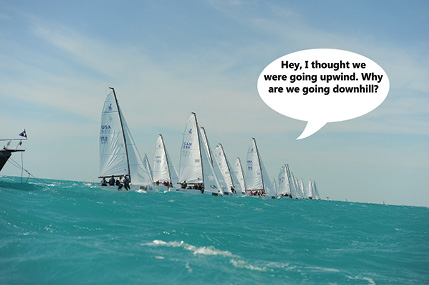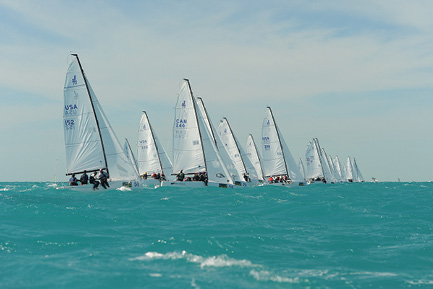Why is composition so important?
You can position yourself in the perfect spot on the water all day long, use the best gear money can buy, and know how to set your camera as well as Ansel Adams did. But if you don’t pay attention to composition, you’ll end up with terabytes of files in storage and only a very few good shots.

One basic example of (1) poor and (2) good composition. These shots of Swan 42 Mahalo sailing upwind in Key West were taken within a second or two of each other. Which one looks better to you? The first is not well-composed, as the boat is leaving the frame and the bow is cut off. The second is a lot more pleasing to the eye.
Composition Tip 1: Always have a straight horizon

This J/70 start shot is off-balance, and should not be published anywhere except as a cartoon!
In sailboat racing, a horizon job is the term for winning by a significant amount, being so far ahead, you’re over the horizon.
In sailboat racing photography, a horizon job is what you do to thousands of photos with your photo editing software after a day on the water. It’s not nearly as glamorous; it’s just plain tedious. The best way to manage your workflow is to get the horizon right when you take the shot!

Much better! A quick crop and these J/70s are sailing on even water again.
But it is difficult to take photos with straight horizons. You really have to think about it while you take the photo. It’s surprisingly easy to concentrate only on the boat, and think you got the horizon straight, only to look at the photo later on your computer and realize the horizon in the background slants at nearly 45 degrees. Like everything, creating images with straight horizons takes practice. And until you get better at it, you’ll be spending hours on the computer doing the horizon job!

These two images are two different crops of the same photo. Image (1) does not break any major composition rules, except that it’s not quite close enough. Image (2) looks more dramatic.
Composition Tip 2: Fill the frame
If you have too much empty space around the subject of the photo, the photo is more likely to be unexceptional. You must be close enough! Have you taken photos of beautiful but far away boats, where the boat fills 25% of the frame or less? Then when you looked back at them, you were underwhelmed? This is common.

These two photos were taken seconds apart, from very slightly different angles in the vicinity of the windward mark. Due to light wind and somewhat flat light, neither of these two photos is exceptional. However, while photo (1) lacks organization, photo (2) has a subject.
The tricks to filling the frame: have a powerful zoom lens, get close, and within reason, crop in post-production. Digital zoom (cropping) will always be more “lossy” than optical zoom, but if you didn’t take the photo quite close enough to begin with, and you have a high quality DSLR (digital single-lens reflex) camera, you can and should crop in some to make the photo fill the frame.
Composition Tip 3: The boat should be coming straight at you
While there are times that a side-on or stern shot is desirable, of course, we most often aim to take photos with boats coming straight at us. This approach provides an extra element of drama, even in lighter wind conditions, and like most composition principles, it just makes the photo feel right to the viewer.
While horizons can sometimes be fixed during post-processing, it’s impossible to use PhotoShop to make the boat come straight at you! It’s all about being in the right place on the water, and snapping the shutter at just the right time. Having a longer zoom lens helps with success here, as it can allow you to shoot boats that are farther away. But we’re not talking about miles here, just a couple of boat-lengths. The moral of the story: be on a collision course! But be sure to get out of the way!
Composition Tip 4: The boat should not be exiting the frame
A photo is composed properly if the bow of the boat does not look like it’s about to leave the photo. In other words, there should be more room in front of the boat than behind it. It’s not common for a sailboat to go backwards, so this is a fairly safe rule to follow!
To get this technique down on the water, think as if you’re taking a video of the boat without being able to pan at all. You would want to press the record button while the boat still has some room to sail before exiting the frame.

Photo (1) is properly composed. The photographer has allowed room for the eye to imagine the boat continuing on its course. Photo (2) gets a “thumbs down” as the boat is about to leave the frame.
One Final Tip
Editing your photos diligently to try to create well-composed images will help you improve your quality straight out of the camera next time you shoot, and then you’ll spend less time editing. Oh, and once you really know the composition rules, you’ll know when it’s okay to break them! ■
Daniela & Allen Clark met when they were instructors at Longshore Sailing School in Westport, CT, and they launched started PhotoBoat.com in 2005. They are very nice people whose superb photographs appear in every issue of WindCheck, often on the cover.
Their instructional ebook, Composition Tips for Boat Photography, is highly recommended. To download the ebook with more tips, visit https://www.photo-boat.com/ebook.



